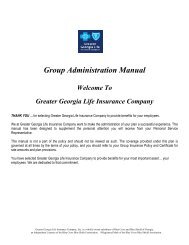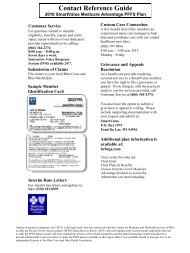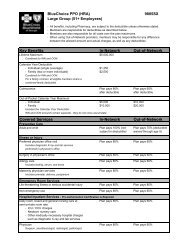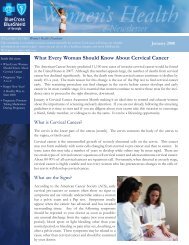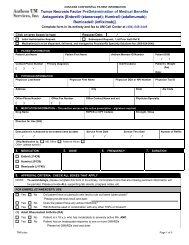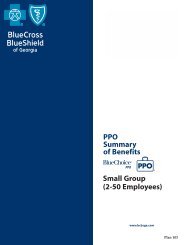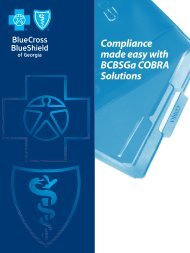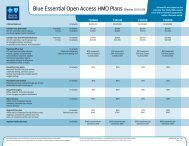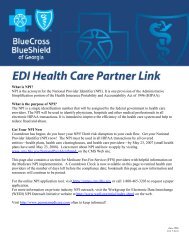Wellness Flyer: Skin Cancer - Time Well Spent - BCBSGa
Wellness Flyer: Skin Cancer - Time Well Spent - BCBSGa
Wellness Flyer: Skin Cancer - Time Well Spent - BCBSGa
- No tags were found...
You also want an ePaper? Increase the reach of your titles
YUMPU automatically turns print PDFs into web optimized ePapers that Google loves.
Get Healthy. Stay Healthy.<strong>Skin</strong> cancer<strong>Skin</strong> cancer is the most common form of cancer in the United States,but it is also one of the most preventable. 1 Since more than 90 percentThe ABCDEs of melanoma 6Melanoma is the most serious formof all skin cancers are caused by sun exposure, taking simple steps toof skin cancer, but it is nearly alwaysprotect yourself can significantly reduce your risk. 2Evaluate your riskWhile everyone is at risk for damage from the sun, certain groups of people areat a greater risk for developing skin cancer. Factors that lead to an increasedrisk include: 3<strong>Skin</strong> typePeople with light skin that freckleseasily, blond or red hair, or blue or greeneyes are more likely to get skin cancerthan people with darker complexions.Also, the more moles you have, thegreater your likelihood of developingcancer. 3,4<strong>Time</strong> spent outdoorsIf your work or hobbies keep yououtdoors much of the time, your riskis greater.Where you liveSouthern parts of the country are closerto the equator and get more sun, sopeople who live in these areas are at agreater risk for skin cancer than thosewho live in the northern U.S. 4Personal historyYou are more likely to develop skincancer if you have: 3,4| | Suffered serious sunburns earlyin life.| | Used tanning beds.| | Had any type of skin cancerbefore.| | Weakened your immunesystem due to excessiveunprotected exposure to the sun,chemotherapy, organ transplant,lymphoma or HIV/ AIDS.Family historyIf one of your parents, siblings orchildren has had certain types of skincancer, you have a 50 percent greaterchance of developing it as well. If it wasa grandparent, aunt or uncle, or niece ornephew, there is also an increased risk. 5curable if it is caught early. Know thedifference between a normal, harmlessmole and one that could be cancerousby evaluating growths for these fivetraits:Asymmetry. The two halves of themole do not match if you were to drawa line through it.Border. An early melanoma often hasuneven edges.Color. A growth that is more than onecolor should prompt a visit to yourdoctor for further evaluation.Diameter. A melanoma is usuallylarger than the size of a pencil eraser,although they can be smaller whenfirst detected.Evolving. Any change in size, shapeor color, or any new symptom such asbleeding, itching or crusting, is a signthat you should make a call to yourdoctor.If you notice any change on your skin,including new growths, moles that arechanging, sores that won’t heal or evensymptoms that seem like eczema orpsoriasis, make an appointment withyour doctor. <strong>Skin</strong> cancer treatmentsare much more effective on cancersthat are caught early.
Protect yourself 1,3The best way to prevent skin cancer is to avoid the sun. Try to stay inside or in the shadebetween 10 a.m. and 4 p.m., when ultraviolet rays are the strongest and most damaging.Wear sunscreen that offers ultraviolet A (UVA) and ultraviolet B (UVB) protection, with asun protective factor (SPF) of 15 or higher every time you go outside. Be sure to reapplysunscreen at least every two hours and whenever you have perspired heavily, goneswimming or dried off with a towel – even if your sunscreen is waterproof. And wearprotective clothing, including a wide-brimmed hat and wraparound sunglasses that block asclose to 100 percent of UVA and UVB rays as possible.Know the warning signsThe good news is that skin cancer is curable, particularly when detected early. Knowing howto recognize the warning signs and performing a monthly skin check can help you catch aproblem before it is too late. An annual exam by a dermatologist is another key part of anearly detection strategy. Signs of a problem include: 7| | An open sore or bump that itches, bleeds, crusts over and then repeatsthe cycle and has not healed in three weeks| | A red, irritated patch on the skin| | A shiny bump of any color| | A pink growth with an elevated border and a crustedindentation in the center or a growth that looks like a wart| | A scar-like area where the skin is shiny and tightResourcesFor more information and tips onprotecting yourself from the sun,visit the Sun Safety Alliance atsunsafetyalliance.orgOr check out the SHADEFoundation of America atshadefoundation.org for a list offun indoor activities to keep yourfamily entertained during the peakhours for ultraviolet radiation.Asymmetry, uneven borders, more than one color, large diameteror changes to moles – these are the ABCDEs of melanoma, the mostdangerous form of skin cancer.Visit bcbsga.com for more ways to gethealthy — and stay healthy.The information contained in this flier is provided for educational purposes only, and should not be interpreted as medical advice. Please consult your doctor for medical advice about changes that may affect your health and before taking any medications or beginning any lifestyleprogram. Some services may not be covered under your health plan. Please refer to your Group Certificate and Schedule of Benefits for details concerning benefits, procedures and exclusions.Sources:1Prevent <strong>Cancer</strong> Foundation, <strong>Skin</strong> <strong>Cancer</strong> 2009 Fact Sheet (Accessed March 5, 2010): preventcancer.org2<strong>Skin</strong> <strong>Cancer</strong> Foundation, <strong>Skin</strong> <strong>Cancer</strong> Facts (Accessed March 6, 2010): skincancer.org3Centers for Disease Control and Prevention, <strong>Skin</strong> <strong>Cancer</strong> (July 7, 2009): cdc.gov4American Academy of Dermatology, ABCDEs of Melanoma Detection (2010): aad.org5National <strong>Cancer</strong> Institute, What You Need To Know About <strong>Skin</strong> <strong>Cancer</strong> (July 30, 2009): cancer.gov6<strong>Skin</strong> <strong>Cancer</strong> Foundation, Understanding Melanoma (2010): skincancer.org7WebMD, <strong>Skin</strong> <strong>Cancer</strong>, Non-Melanoma Guide (October 14, 2008): webmd.comBlue Cross and Blue Shield of Georgia, Inc., is an independent licensee of the Blue Cross and Blue Shield Association. The Blue Cross and Blue Shield names and symbols are registered marks of the Blue Cross and Blue Shield Association.MGASH2469BGA 3/10



